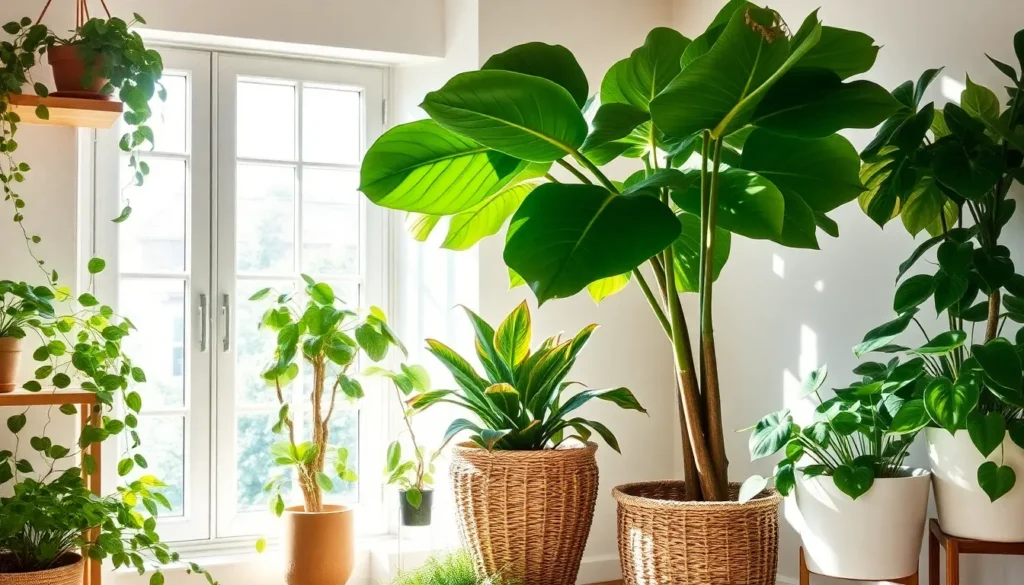Imagine stepping into a home where the air is as fresh as a serene forest, and every breath feels like a cleansing sigh. Houseplants, with their lush leaves and vibrant presence, offer more than just aesthetic charm; many of them are silent warriors in our quest for cleaner air. Whether you’re a seasoned gardener or just beginning to explore the world of indoor plants, the idea of nurturing greenery that also purifies your living space is both exciting and rewarding.
In our fast-paced world, where pollution is an ever-present concern, bringing a touch of nature indoors can make a significant difference. This article will introduce you to ten stunning houseplants that not only elevate your home’s style but actively work to rid the air of toxins. You’ll discover which plants are best suited for various lighting conditions and how to care for them so they thrive in your home environment.
For those new to plant care, these houseplants offer a gentle introduction to the joy of gardening, with the added benefit of improving your air quality. Experienced gardeners will find satisfaction in diversifying their plant collections with these beneficial varieties. By the end of this article, you’ll be equipped with both the knowledge and inspiration to transform your living space into a vibrant, healthy oasis.
Introduction to Air-Purifying Plants
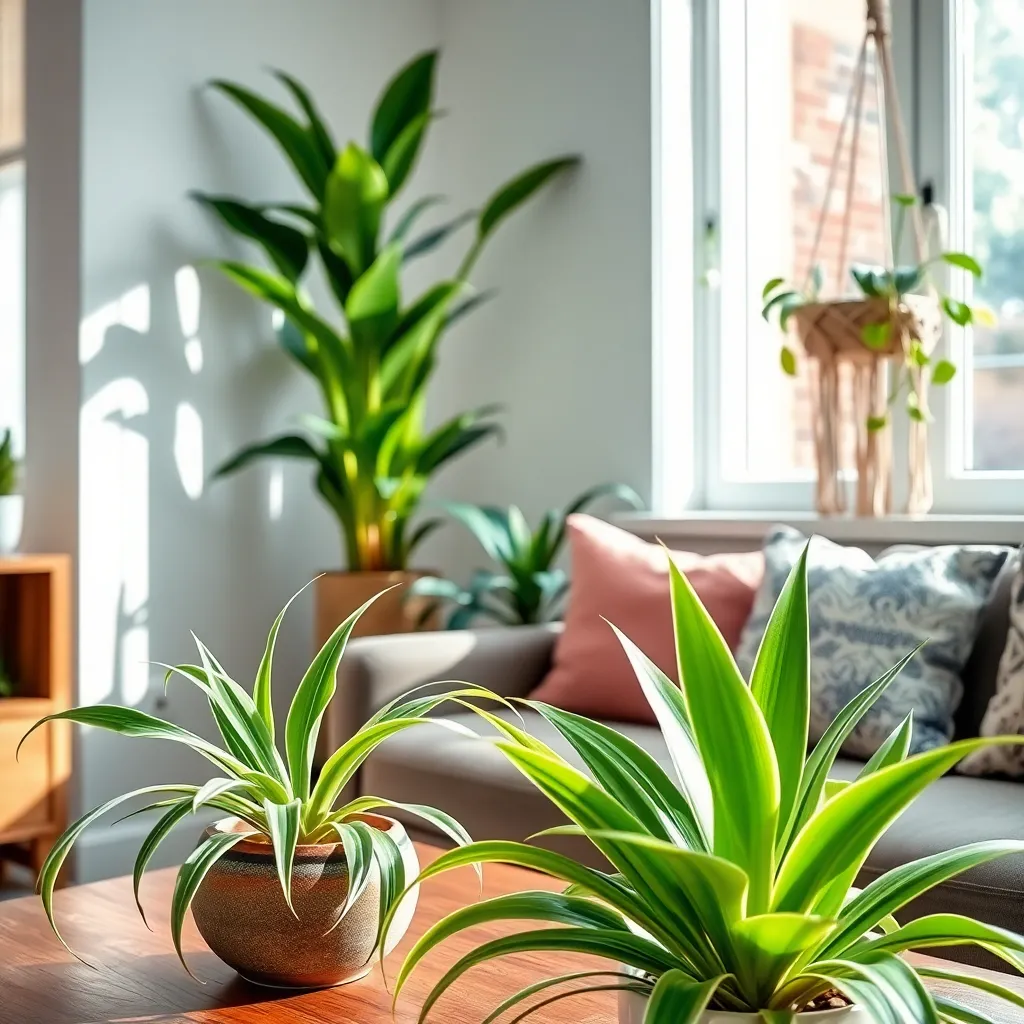
Houseplants that purify the air not only enhance the aesthetic appeal of your home but also improve indoor air quality. These plants work by absorbing toxins through their leaves and roots, making them an excellent choice for any living space.
When choosing air-purifying plants, consider their specific light and water requirements to ensure they thrive. Most of these plants prefer indirect light and moderately moist soil, making them suitable for various indoor environments.
Beginners should start with easy-care plants like the Snake Plant or Spider Plant, which are known for their resilience and low maintenance. These plants can tolerate a range of conditions, but they do best with well-draining soil and occasional watering.
For more advanced gardeners, consider adding a Peace Lily or Boston Fern to your collection. These plants require slightly more attention, such as maintaining higher humidity levels and ensuring they have consistent moisture without becoming waterlogged.
Benefits of Indoor Air Quality
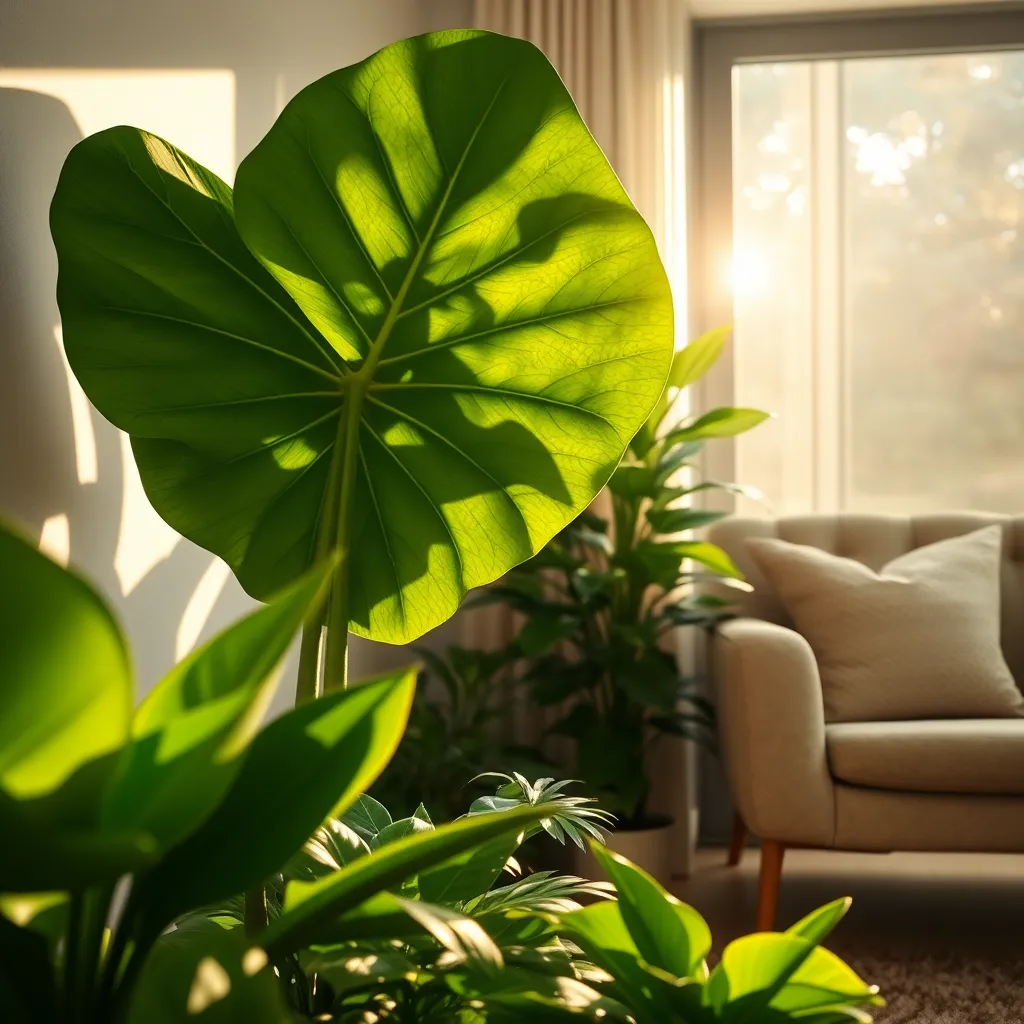
Improving indoor air quality with houseplants is a simple and effective way to enhance your living environment. These plants absorb pollutants and release oxygen, making your home a healthier place to breathe.
Placing houseplants in your living space can also help regulate humidity levels. This is particularly beneficial in drier climates, where maintaining moisture in the air is crucial for comfort and health.
For beginners, starting with low-maintenance plants such as the Snake Plant or Peace Lily is advisable. Both thrive in indirect light and require minimal watering, making them perfect for busy individuals or those new to gardening.
Advanced gardeners might enjoy experimenting with the Boston Fern, which not only cleans the air but also adds lush greenery to any room. Ferns prefer a humid environment and consistently moist soil, so regular misting and a well-draining pot are essential.
To maximize the air-purifying benefits, consider grouping several plants together. This not only creates a more significant impact on air quality but also introduces a beautiful, natural aesthetic to your home decor.
Choosing the Right Houseplants
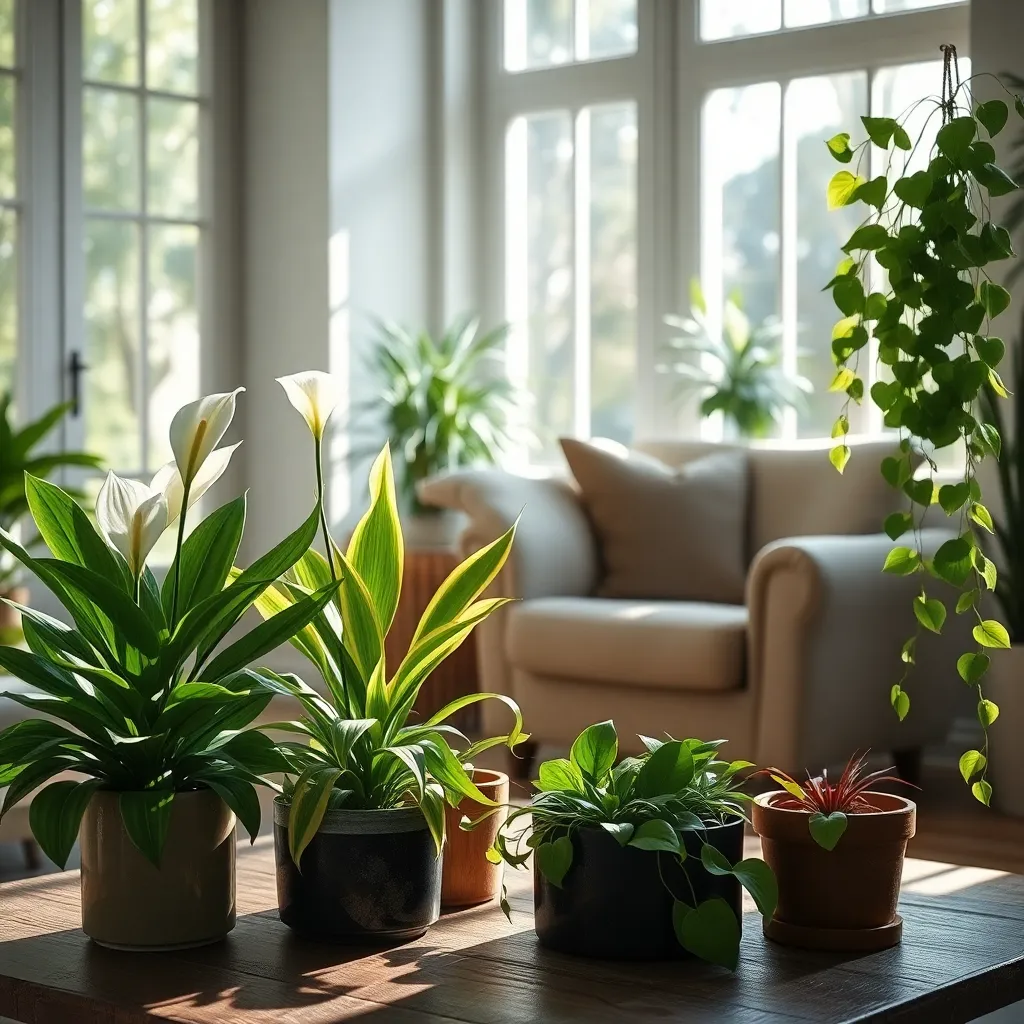
Choosing the right houseplants involves considering both aesthetic preferences and environmental needs. Begin by assessing the light conditions in your space, as this will guide you toward plants that will thrive.
Low-light conditions are ideal for plants like snake plants and pothos, which can thrive with minimal sunlight. These plants are also forgiving, making them perfect for beginners who might still be learning the nuances of plant care.
On the other hand, spaces with bright, indirect light can house plants like the peace lily or spider plant. These plants not only purify the air but also add vibrant greenery to your interiors.
When selecting houseplants, consider the humidity levels in your home. High-humidity environments support plants such as ferns and calatheas, which will appreciate occasional misting or a nearby humidifier.
Soil type is another critical factor in keeping your plants healthy. Most houseplants prefer well-draining soil, so consider a cactus mix for succulents or a peat-based mix for tropical plants.
Watering frequency can vary significantly between different types of plants. As a general rule, allow the top inch of soil to dry out between waterings for most houseplants, but be sure to research specific needs for each variety.
Advanced gardeners might explore the benefits of fertilizing their houseplants to enhance growth and health. A balanced liquid fertilizer applied monthly during the growing season can keep your plants in peak condition.
Peace Lily: Aesthetic and Efficient
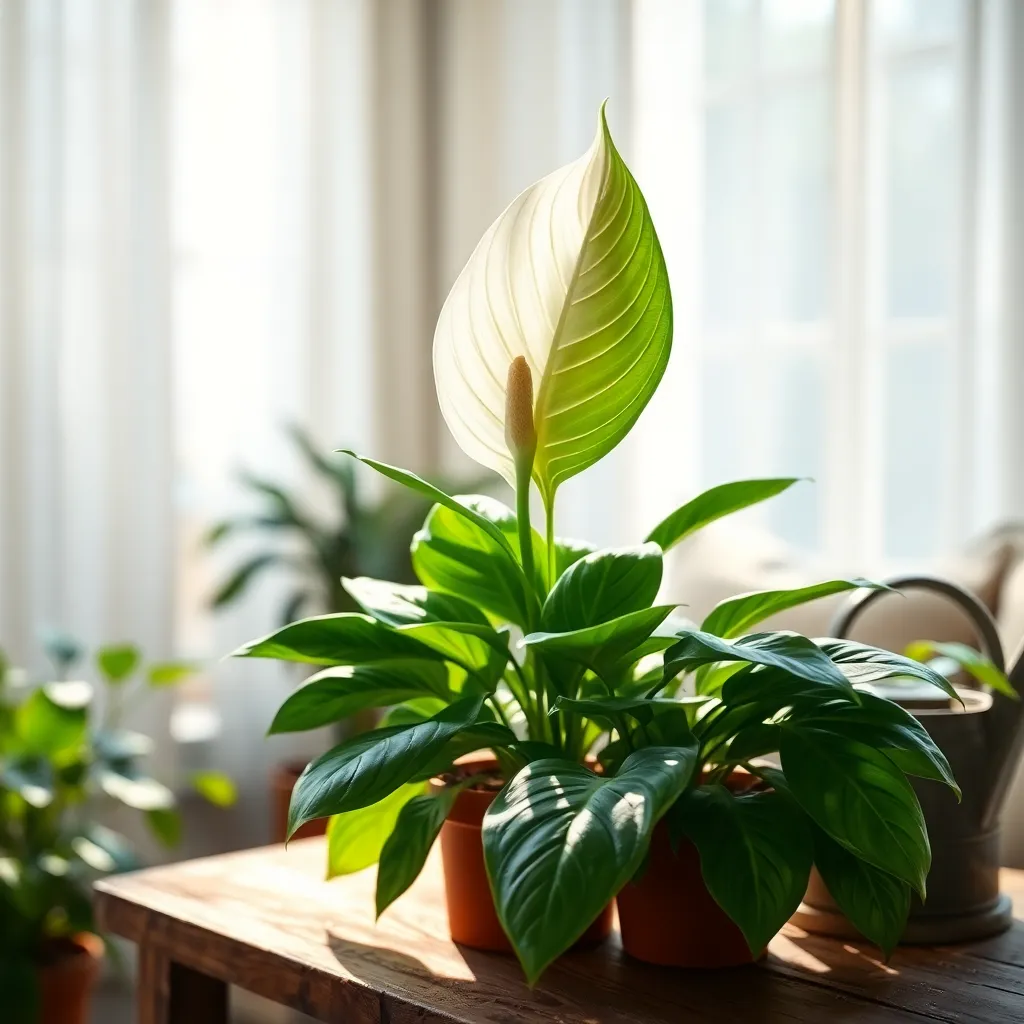
The Peace Lily is not just a stunning addition to any room, but it’s also highly efficient at purifying the air. This tropical plant is renowned for its ability to remove toxins like ammonia, benzene, and formaldehyde, making it a beneficial choice for health-conscious gardeners.
To keep your Peace Lily thriving, place it in a location with indirect sunlight, as direct sunlight can scorch its leaves. If you notice the leaves are yellowing, it may be a sign of too much light, so adjust its placement accordingly.
Maintaining the right moisture level is crucial for a healthy Peace Lily. Water it approximately once a week, ensuring the soil is kept moist but not soggy, and allow the top inch of the soil to dry out between waterings to prevent root rot.
For those looking to enhance their Peace Lily’s growth, consider repotting every couple of years using a well-draining potting mix. An all-purpose soil mix with added perlite or orchid bark is ideal, as it provides the right balance of moisture retention and aeration.
Spider Plant: Low-Maintenance Purifier
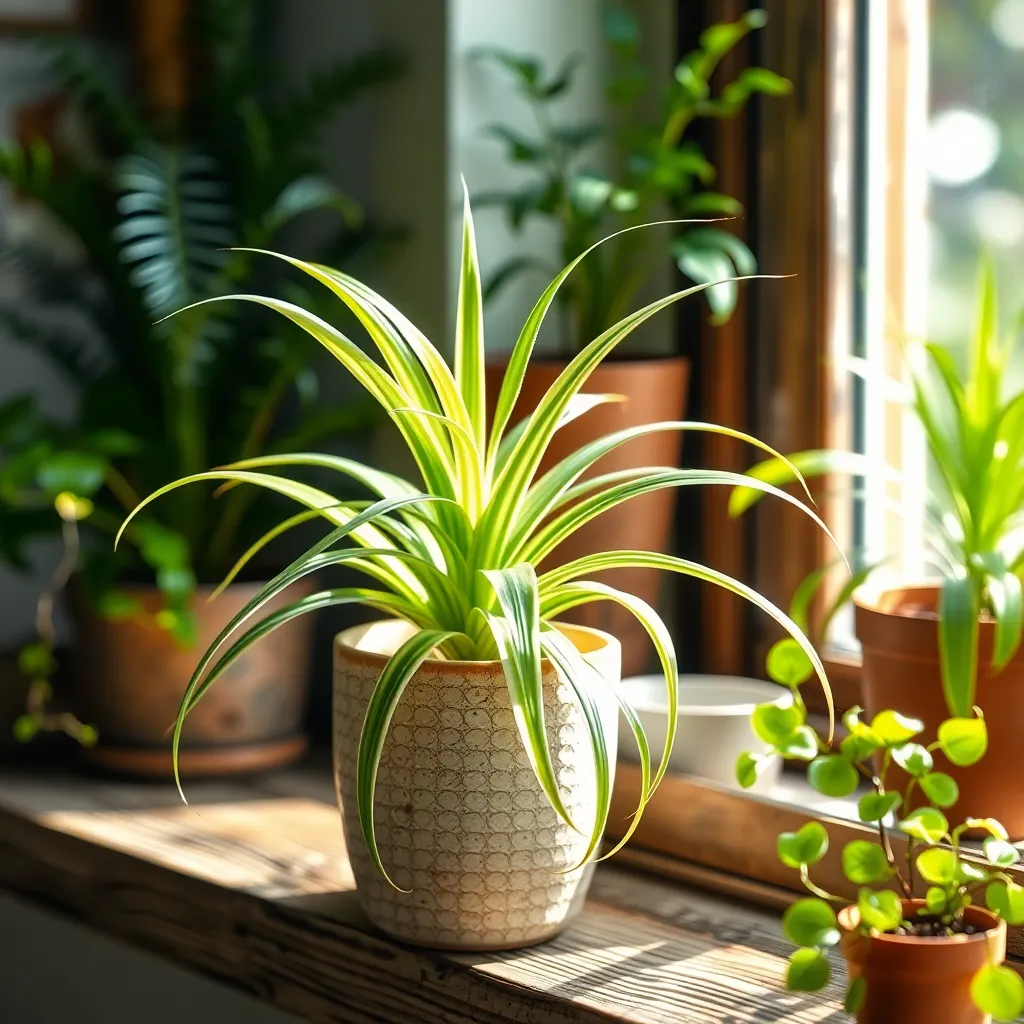
Known for its striking, arching leaves, the spider plant is a fantastic choice for those seeking an easy-to-care-for houseplant. Its ability to purify the air by removing pollutants like formaldehyde and xylene makes it a valuable addition to any home.
To successfully grow a spider plant, place it in bright, indirect light. While it can tolerate lower light conditions, optimal growth occurs when it receives plenty of indirect sunlight, so consider positioning it near a window with filtered light.
Water your spider plant moderately, allowing the top inch of soil to dry out between waterings. Overwatering can lead to root rot, so it’s crucial to ensure that the plant’s pot has good drainage and to use a well-draining potting mix, such as a peat-based soil.
For those looking to propagate, spider plants are particularly rewarding as they produce small offshoots, or “spiderettes,” that can be easily rooted. Simply place these spiderettes in water or soil, and within a few weeks, you’ll have new plants to share or expand your indoor garden.
Snake Plant: Hardy and Helpful
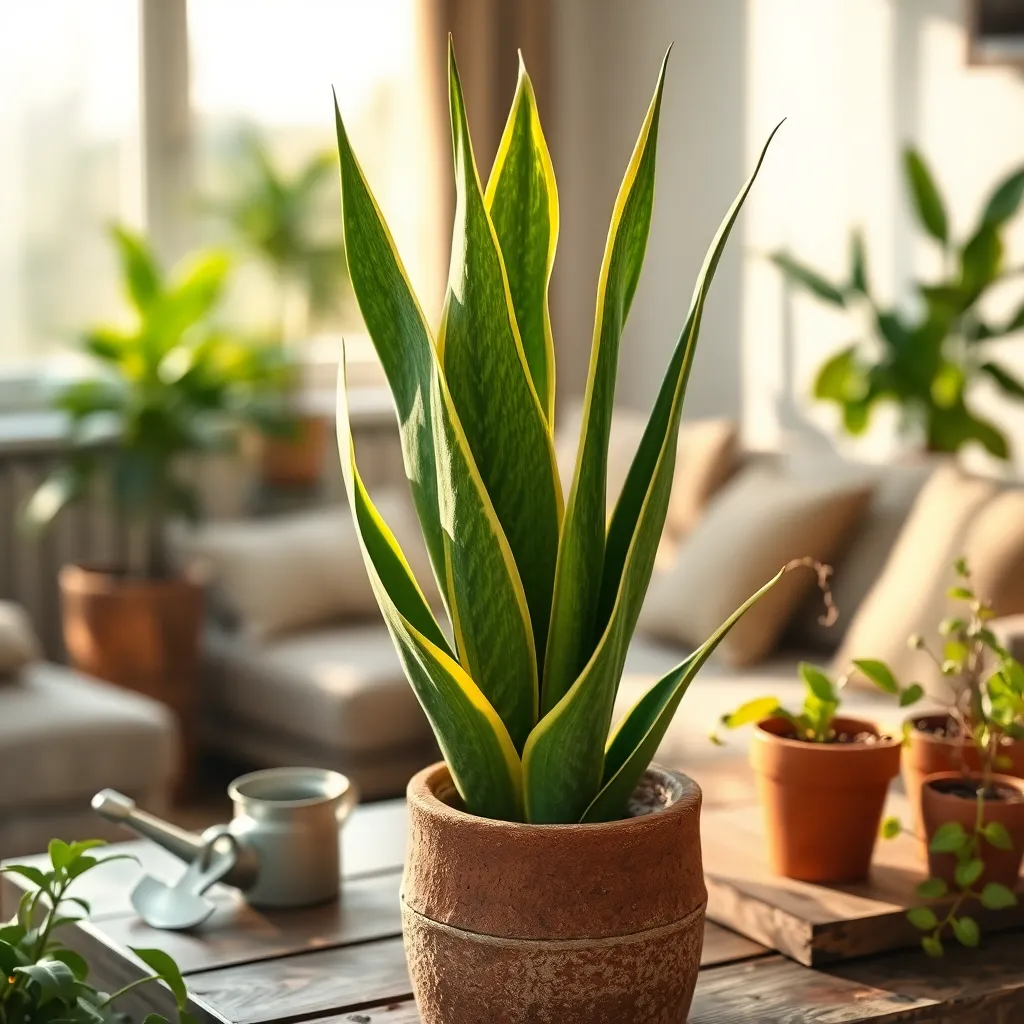
Snake plants, also known as Sansevieria or mother-in-law’s tongue, are renowned for their resilience and air-purifying abilities. These hardy houseplants are perfect for beginners due to their low maintenance requirements and ability to thrive in a variety of indoor conditions.
One of the key benefits of snake plants is their ability to filter indoor air, removing toxins such as formaldehyde and benzene. They perform photosynthesis primarily at night, making them excellent companions in bedrooms to improve air quality while you sleep.
To keep your snake plant healthy, place it in a pot with a well-draining soil mix, such as a blend of cactus soil and perlite. Snake plants prefer indirect sunlight, but they can tolerate low-light conditions, making them versatile for different areas of your home.
Water your snake plant sparingly, allowing the soil to dry out completely between waterings. Overwatering can lead to root rot, so it’s best to err on the side of caution, especially during the winter months when the plant’s growth slows.
For experienced gardeners, consider propagating your snake plant by dividing the rhizomes or using leaf cuttings. This not only increases your plant collection but also helps maintain the plant’s vigor and encourages new growth.
Aloe Vera: Healing and Cleansing
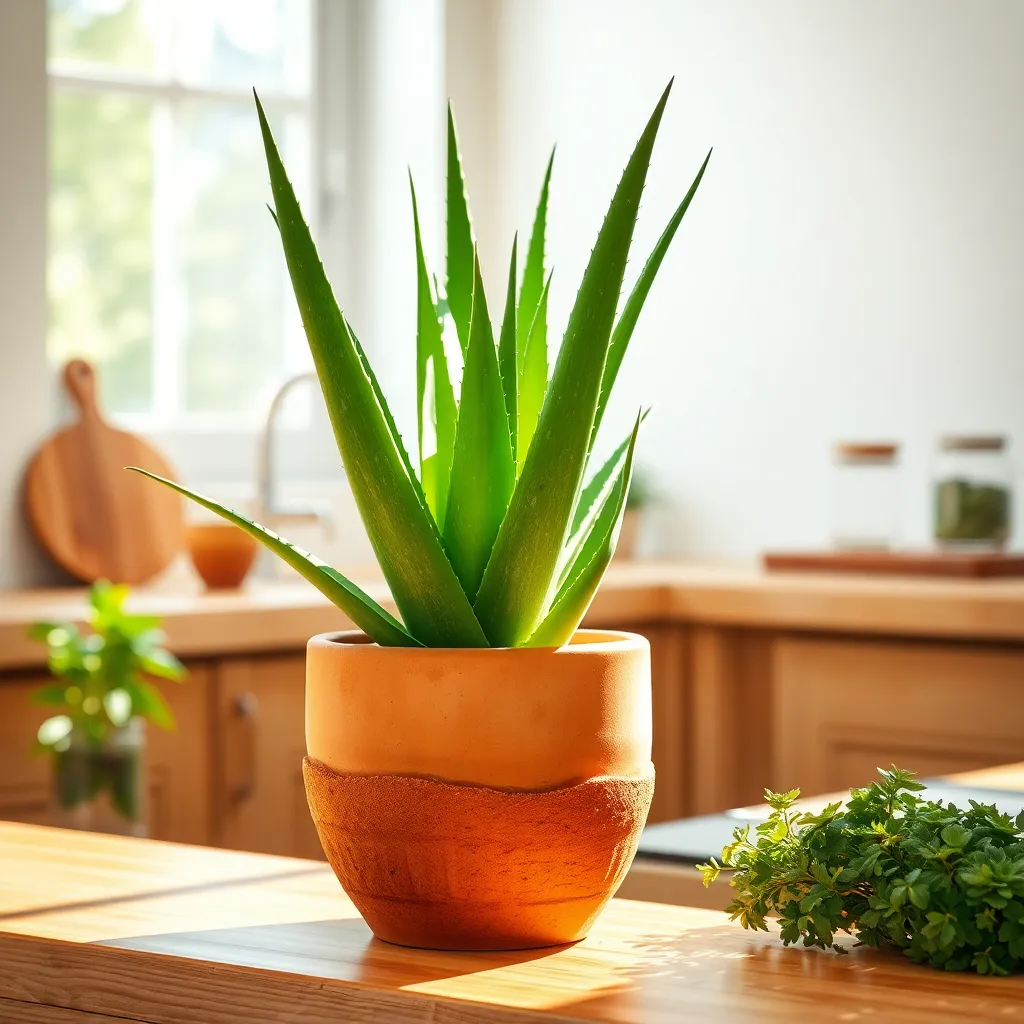
Aloe Vera is not only a striking addition to your home, but it also serves as a natural air purifier. Known for its healing properties, Aloe Vera can help remove toxins like formaldehyde and benzene from the air, making your indoor environment healthier.
To grow Aloe Vera successfully, place it in a spot that gets plenty of bright, indirect sunlight. It thrives in well-draining soil, so consider using a cactus potting mix or adding sand to regular potting soil to improve drainage.
Water your Aloe Vera sparingly, allowing the soil to dry out completely between waterings to prevent root rot. During the warmer months, aim to water every three weeks, and reduce this frequency in winter when the plant’s growth slows down.
For those looking to propagate their Aloe Vera, simply remove and pot the offsets, or “pups,” that appear at the base of the plant. This is an easy way to expand your plant collection and enjoy more of this beneficial plant around your home.
Boston Fern: Humidity-Loving Freshener
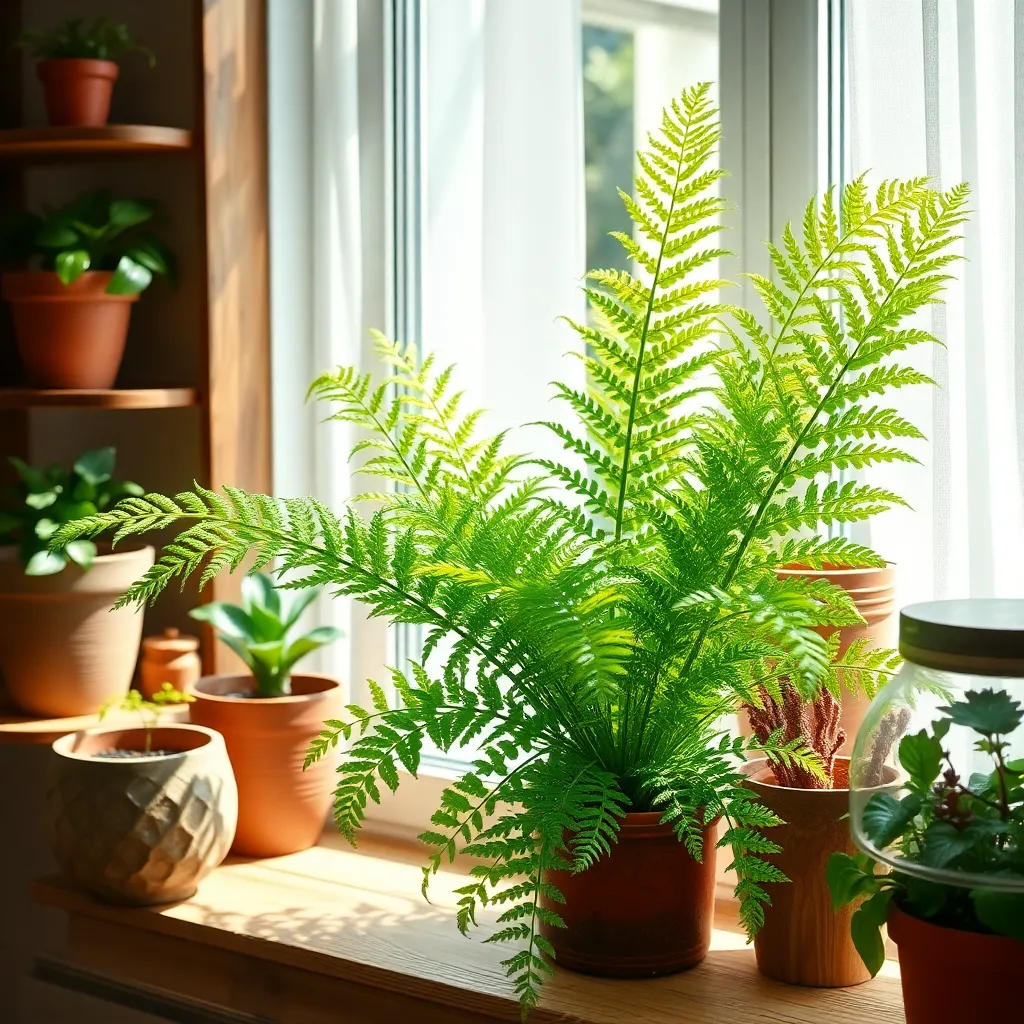
The Boston Fern, known for its lush, feathery fronds, thrives in high humidity environments, making it an excellent natural humidifier for your home. This plant not only beautifies spaces but also efficiently removes toxins such as formaldehyde from the air, enhancing your indoor air quality.
To keep a Boston Fern healthy, place it in a location with indirect light, such as a north-facing window or a shaded patio. It’s crucial to maintain consistent moisture in the soil; water when the top inch feels dry, but ensure the pot has drainage to prevent root rot.
For the best results, use potting soil rich in organic matter to mimic the fern’s natural habitat. Adding a layer of mulch on top of the soil can help retain moisture and keep the roots cool, further promoting healthy growth.
Advanced gardeners might consider misting the fronds regularly or using a pebble tray filled with water to maintain the high humidity levels Boston Ferns love. During the growing season, feeding the plant with a balanced liquid fertilizer every month will encourage lush foliage and vibrant growth.
Rubber Plant: Elegant and Effective

The Rubber Plant, also known as Ficus elastica, is a striking addition to any indoor plant collection, celebrated for its glossy, dark green leaves. Not only does it add a touch of elegance to your home, but it also effectively purifies the air by removing toxins such as formaldehyde.
For optimal growth, place your Rubber Plant in a spot with bright, indirect light, as direct sunlight can scorch its leaves. If you’re a beginner, ensure the soil is well-draining, using a mix of peat, pine bark, and perlite to provide the right balance of moisture retention and aeration.
Water your Rubber Plant when the top inch of soil feels dry to the touch, but be careful not to overwater, as this can lead to root rot. An advanced tip for the more experienced gardener is to increase humidity around the plant by misting its leaves or placing a small humidifier nearby, as this replicates its native tropical environment.
Fertilize your Rubber Plant every month during the growing season (spring and summer) with a balanced liquid fertilizer to encourage robust growth. For those looking to shape their plant, consider pruning to maintain its desired size and remove any dead or damaged leaves, which can also help improve air circulation around the plant.
Caring for Your Air-Cleaning Plants
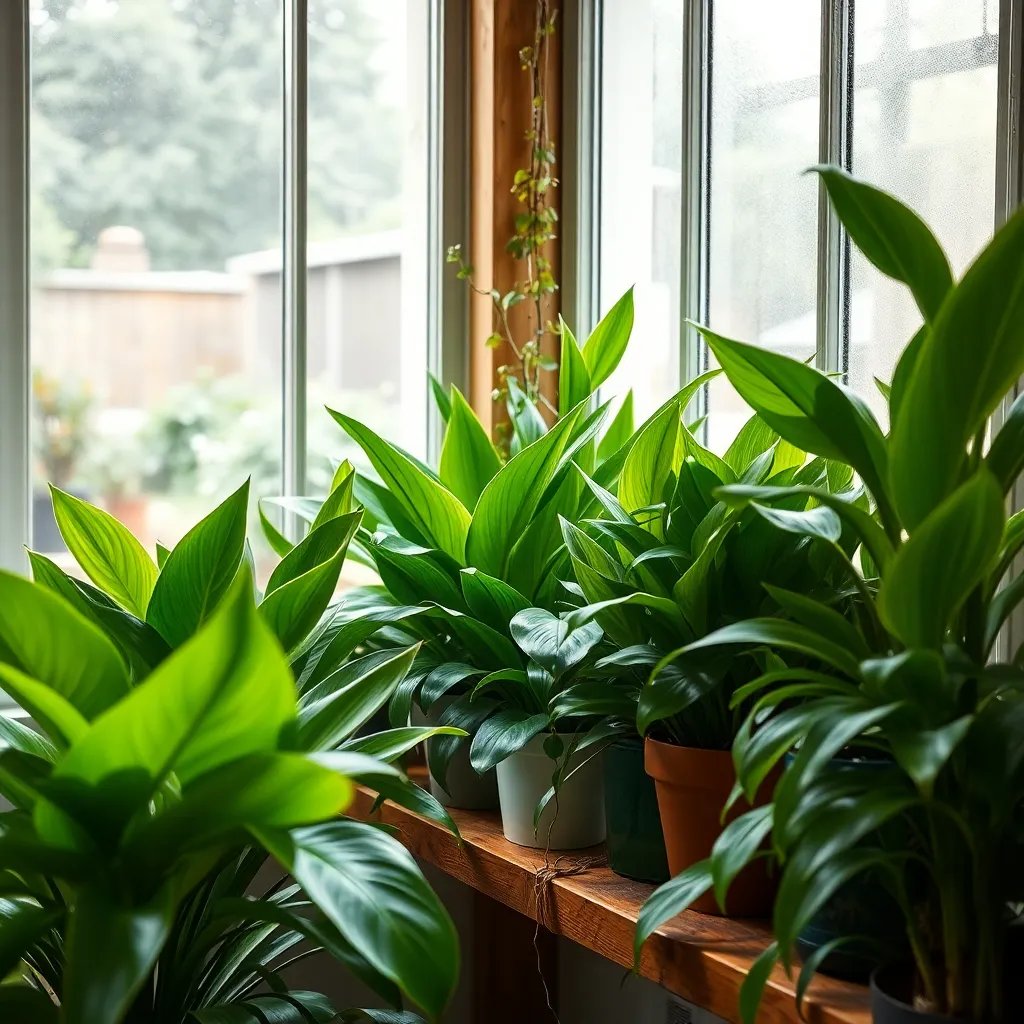
Caring for your air-cleaning plants involves understanding their specific needs to help them thrive. Start by ensuring that each plant is placed in a location where it receives the appropriate amount of light, as this is crucial for its growth and air-purifying capabilities.
Most air-cleaning plants prefer indirect sunlight, so placing them near a window with filtered light is ideal. Consider using sheer curtains to diffuse intense sunlight, preventing leaf scorch and promoting healthy growth.
Watering frequency is another vital aspect of caring for these plants. Typically, allowing the top inch of soil to dry out between waterings works well for many species, but always adjust based on your plant’s specific needs and the humidity levels in your home.
Using the right soil mix can enhance your plant’s health and its ability to clean the air. A well-draining potting mix is recommended, often comprising peat, perlite, and pine bark to ensure proper moisture balance and root aeration.
Fertilizing air-cleaning plants can boost their growth and vitality. During the growing season, apply a balanced, water-soluble fertilizer every month, but be cautious not to over-fertilize, as this can harm the plant.
Advanced care includes regular dusting of leaves to maximize their air-purifying function. Use a soft, damp cloth to gently clean the leaves every few weeks, promoting efficient photosynthesis and maintaining their health.
Conclusion: Growing Success with These Plants
In exploring the intertwining of houseplants and relationships, we’ve journeyed through ten key concepts that enrich both our living spaces and interpersonal connections. From the nurturing commitment of the Peace Lily to the resilient adaptability of the Spider Plant, each plant symbolizes an essential pillar of strong relationships—communication, trust, patience, growth, balance, and understanding. These beautiful houseplants not only cleanse the air but also serve as daily reminders of the care and dedication required to maintain healthy relationships.
As your actionable next step, consider bringing one of these plants into your home. Let it be a living symbol of your commitment to nurturing your relationships. Place it where you and your loved ones gather, and let it inspire conversations about growth and care.
Don’t forget to save or bookmark this article as your go-to guide for both botanical and relational inspiration. As you cultivate your indoor garden, envision a future where your relationships flourish with the same vitality. Remember, just as a well-tended plant thrives, so too can your relationships blossom when nurtured with intention and love. Your journey towards lasting relationship success starts now—embrace it wholeheartedly.

